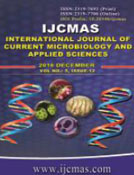


 National Academy of Agricultural Sciences (NAAS)
National Academy of Agricultural Sciences (NAAS)

|
PRINT ISSN : 2319-7692
Online ISSN : 2319-7706 Issues : 12 per year Publisher : Excellent Publishers Email : editorijcmas@gmail.com / submit@ijcmas.com Editor-in-chief: Dr.M.Prakash Index Copernicus ICV 2018: 95.39 NAAS RATING 2020: 5.38 |
The antifungal potential of ozone fumigation was evaluated for growth inhibition of isolated fungi from recurrent mastitis in dairy buffaloes in comparison with some traditional chemical antifungal. One hundred samples were collected from private farm of dairy buffaloes suffering from repeated mastitis affection ( 20 samples of each of litters, swabs of workers hands and rations) and 40 mastitic milk samples from diseased mastitis animals. The predominant fungal isolates that recovered from samples were subjected for ozone fumigation. The effectiveness of ozone treatments on spore germination depended on ozone concentration and treatment duration. The gradual increase in ozone concentration induced progressive retardation of the spore viability and the required time for ozone exposure was decreased. Where, the growth inhibition of mould as A.flavus required exposure to 20 ppm of ozone for 20 minutes ; to 40 ppm for 15 minutes and exposure to 60 ppm of ozone for 10 minutes to be completely inhibited the fungal growth and no mycelia was observed. The ozone exposure of mould at different concentrations for time under 10 minutes not able to inhibit completely their growth and the inhibition was more pronounced with the extension of exposure time. On the other hand, the growth inhibition of yeast was more sensitive for ozone fumigation which required fewer time of exposure (5-10 min). When the treated fungi with ozone fumigation were subjected to scanning by electron microscopy (SEM),showed many destructive changes in morphology and loss of cell integrity and hence its viability and function were inhibited. When ozone concentrations and time of exposure increased, a serious and destructive changes to fungal structure would occur. The field application on selected highly contaminated commercial animal ration with different moulds, evidenced also higher potential antifungal effects of the ozone fumigation. Where, all used concentrations of ozone (20, 40 & 60 ppm) were effective in decontamination when contaminated rations exposed for 20 minutes and more. Therefore, fumigation with ozone gas can be used as a good method for achieving sanitation and decreasing initial microbial load in rations facilities and spoilage on a long term. Otherwise, the animal diseases could be prevented when healthy feed, disinfect storage, processing areas and other utensils which significantly reflected in improving animal health.
 |
 |
 |
 |
 |